Asteroids and Comets August 29, 2022
Project Lead:
Carrie Nugent (Olin College of Engineering)
Raw data:
.xlsx
Tweet
Asteroids and Comets
In collaboration with Carrie Nugent at Olin College of Engineering we asked researchers in the planetary defense community for their opinions on three key topics: discovery of asteroids and comets that could hit the Earth, the possibility of deflecting those asteroids and comets, and the newly developing risks from large numbers of commercial satellites. Experts were drawn from the planetary defense community.
Primary results
- Respondents believe that the top area for improvement in the planetary defense community is its ability to discover large Earthbound asteroids and comets, with 100% of respondents rating discovery over other priorities.
- Experts thought that given five years of warning we had a 41% chance of stopping a medium asteroid – about the size of a cruise ship – but only a 17% chance of stopping a larger asteroid – more than half a mile long. Our chance of stopping a comet was deemed lower than our chances of stopping an asteroid. However, experts stressed that the likelihood of such a large object hitting Earth was very low, happening only once every 550,000 years.
- 74% of respondents were, at the least, moderately concerned about the proliferation of tens of thousands of commercial satellites in Earth’s low orbit, with 42% saying they were “seriously concerned” or “extremely concerned”. A large number of satellites in the future could interfere with work to discover near-Earth or Earthbound asteroids and comets.
-
Question 1
What is the biggest impediment to discovering an upcoming >140 meter diameter impactor?Results
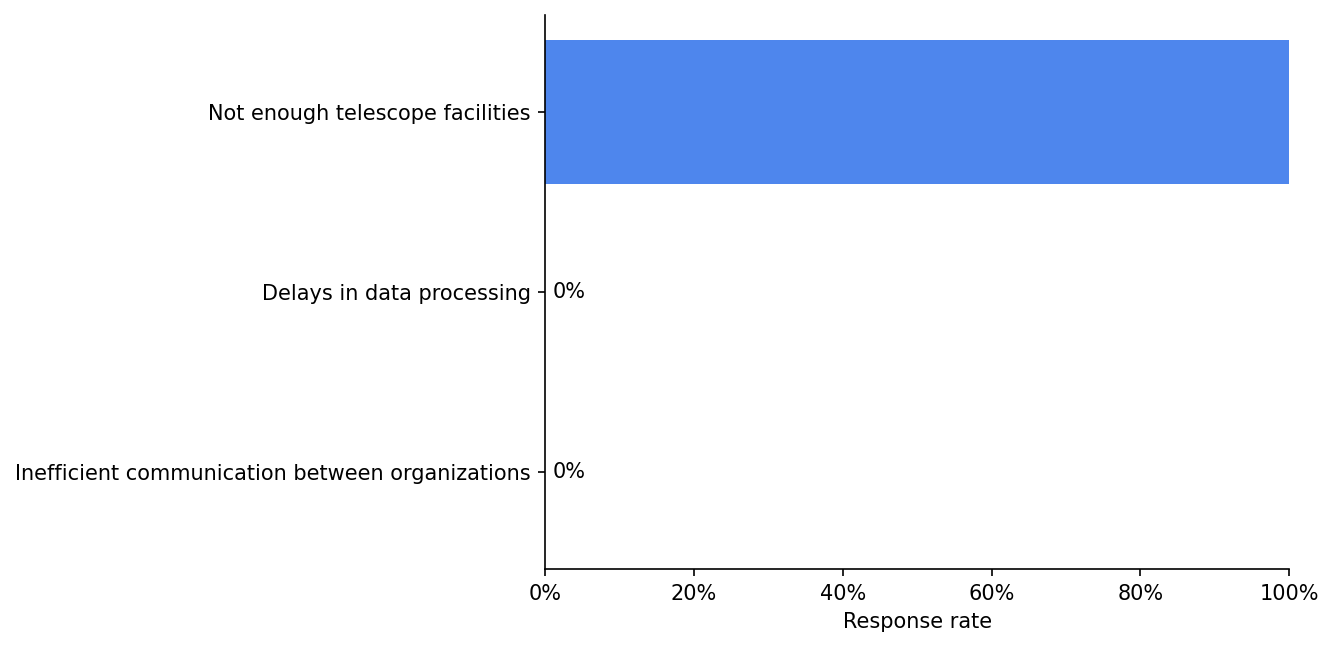
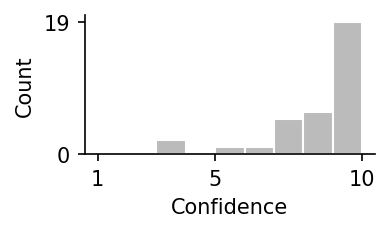
Participant Response Confidence Anonymous
Not enough telescope facilities 10 - We don't have sufficient coverage in the sunward direction. - Since low-hanging >140-m objects have long been discovered, the remaining ones are likely faint (e.g. certain orbital configuration keeps them away from approaching the Earth at the current epoch), hence we need more time on large telescopes to find and confirm them. Anonymous
Not enough telescope facilities 3 The current survey capability will over several decades reach 90% completion of dangerous (>140m) objects, but its ability to provide early-enough warning of a terminal 140m impactor remains unclear. More inexpensive ground-based telescopes can help. Space-based observations can also help, but will be much more costly. Anonymous
Not enough telescope facilities 3 With the new planned telescope facilities it's going to be easy to spot those objects well before their possible impacts. Anonymous
Not enough telescope facilities 9 Not enough LARGER telescope facilities (1-m class telescopes and larger) Cristina Thomas
Northern Arizona UniversityNot enough telescope facilities 7 Space telescopes, like NEO surveyor, will be critical to filling in the discovery gaps. Brent William Barbee
NASA/Goddard Space Flight CenterNot enough telescope facilities 10 Multiple independent studies over the past decade have demonstrated that a space-based IR telescope like NASA's NEO Surveyor design is the best way to discovering Earth-impacting asteroids as early as possible. Anonymous
Not enough telescope facilities 8 I actually don't think it is as much "not enough telescope facilities" as significant delays in those telescope facilities (ground-based and space based) that ARE being designed and built coming online in a real, operational sense. Here I'm thinking about delayed timelines with LSST/Roman and the mission formerly known as NEOCAM! Anonymous
Not enough telescope facilities 9 Anonymous
Not enough telescope facilities 9 Anonymous
Not enough telescope facilities 10 larger facilities can detect fainter objects and thus objects while they are farther away. a space-based IR facility can look closer to the sun/have a different pointing and also can detect objects that are darker in color Alan Harris
Retired, Space Science InstituteNot enough telescope facilities 5 Facilities are adequate, especially with Rubin telescope about to start up, I suggest no greater effort is needed. Anonymous
Not enough telescope facilities 7 The kind of facility is an issue too. Bill Gray
Project PlutoNot enough telescope facilities 6 We do have delay and communication issues, and they could trip us up with a smaller, shorter-term impactor, where hours count. But for a 140-m object, I don't see much of a problem. Anonymous
Not enough telescope facilities 7 Follow up remains a major rate limiting factor in the discovery of NEOs. Anonymous
Not enough telescope facilities 8 Jin Zhu
Beijing PlanetariumNot enough telescope facilities 9 Richard Wainscoat
University of HawaiiNot enough telescope facilities 8 Pan-STARRS could do much better if we could get funding for new cameras on both telescopes. It could see fainter objects, and there would be less objects lost in cell and chip gaps. Additionally, new cameras would allow longer exposure times, further increasing the sensitivity, and better enabling Pan-STARRS to complement the new capability that we expect from the Rubin Observatory in the south. Eric Christensen
The University of Arizona / Catalina Sky SurveyNot enough telescope facilities 9 Delays in data processing and inefficient communication can slow down the discovery process on time scales of hours or days, which is relevant for the discovery of small imminent impactors, but we simply need more sensitive survey instruments to speed up bulk discovery of >140-m NEOs. Anonymous
Not enough telescope facilities 10 Donald K. Yeomans
NASA/JPL - retiredNot enough telescope facilities 7 The use of IR capable telescopes in space, along with ground-based, follow-up optical telescopes, would be allow an effective discovery and characterization process. Anonymous
Not enough telescope facilities 10 To discover NEOs in the optical you need to cover a lot of sky with a large aperture. ATLAS does a lot of coverage but is limited by magnitude. We need to go to ~V25 which means we need a space asset, if not, it will take 20-30 years to complete the survey. Lindley Johnson
NASA HQ PDCONot enough telescope facilities 9 To add, it is not the number of telescope facilities but those with the right capabilities for detection, tracking and characterization of NEAs. Just more inadequate telescopes will not fix the shortfall. Detlef Koschny
European Space AgencyNot enough telescope facilities 10 I would like to note that we should not just focus on object >140 m. A cost-benefit analysis at ESA showed that over the next few hundred years, we'd expect most damage (in terms of financial impact) from objects 20 to 80 m in size. Simply because they are more frequent than larger objects. Anonymous
Not enough telescope facilities 7 Fabrizio Bernardi
SpaceDySNot enough telescope facilities 9 Timothy B. Spahr
NEO Sciences, LLCNot enough telescope facilities 10 There are several hundred 140m diameter objects found each year. We need to increase this by 10x; this means more telescopes, and likely space-based systems. Anonymous
Not enough telescope facilities 10 Anonymous
Not enough telescope facilities 8 studies have shown that it will take a few years to discover ~90% of NEOs > 140m if LSST + NEOSM work in tandem. Without them, not even a decade with the current assets would be enough, the completion would be only about 60-70% in the next 10-15 years. Michael W. Busch
SETI InstituteNot enough telescope facilities 8 My response to the previous question would change given the Vera Rubin Observatory and the NEO Surveyor spacecraft beginning operations. Mark Boslough
Los Alamos National Laboratory & University of New MexicoNot enough telescope facilities 9 I'm not a involved in surveys but whatever data delays and communications inefficiencies exist should be easily fixable. More telescope facilities require more funding and lead time so should be prioritized. Anonymous
Not enough telescope facilities 8 If NEO Surveyor launches, that will help a lot. For characterization, it would be nice to replace Arecibo! Anonymous
Not enough telescope facilities 10 William Bottke
Southwest Research InstituteNot enough telescope facilities 10 There is a trade between the ability of the survey and the timescale it takes to find all of the D > 1 40 m bodies. If we want to reach the goal quickly, we need more capable surveys. Anonymous
Not enough telescope facilities 9 -
Question 2
In which areas do you think the planetary defense community most urgently needs to improve? Please rank your answers.- • Discovery
- • Orbit characterization
- • Physical characterization
- • Deflection technology
- • International governmental cooperation
- • Legal framework around deflection
- • Communication with public
Results
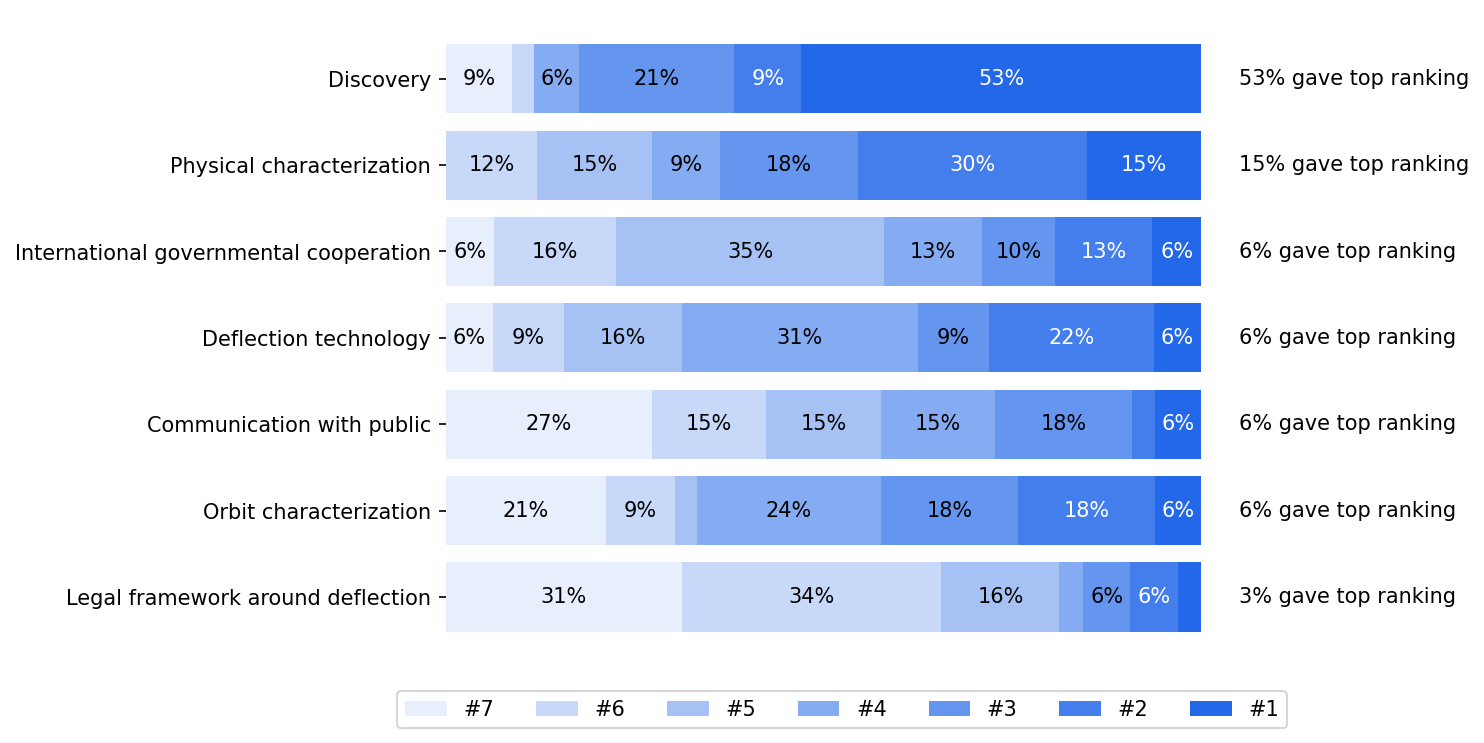
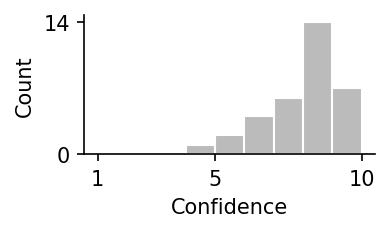
Participant Response Confidence Anonymous
Discovery: 7 Orbit characterization: 6 Physical characterization: 5 Deflection technology: 2 International governmental cooperation: 1 Legal framework around deflection: 3 Communication with public: 4 7 Emerging economies (e.g. China, India) are largely sidelined in many aspects of planetary defense and that is not a good idea moving forward. Anonymous
Discovery: 1 Orbit characterization: 5 Physical characterization: 4 Deflection technology: 2 International governmental cooperation: 6 Legal framework around deflection: 7 Communication with public: 3 4 Anonymous
Discovery: 3 Orbit characterization: 6 Physical characterization: 1 Deflection technology: 4 International governmental cooperation: 2 Legal framework around deflection: 5 Communication with public: 7 8 Physical properties are very useful to find out what kind of deflection mission we want to carry on and I don't think that our knowledge of physical properties is enough at the moment. We are also pretty good at characterizing orbits pretty quickly at the moment, but we can't say the same for physical properties. Anonymous
Discovery: 2 Orbit characterization: 4 Physical characterization: 1 Deflection technology: 3 International governmental cooperation: 5 Legal framework around deflection: 6 Communication with public: 7 8 It could mean international governmental cooperation all over the world(!). Cristina Thomas
Northern Arizona UniversityDiscovery: 1 Orbit characterization: 7 Physical characterization: 6 Deflection technology: 5 International governmental cooperation: 3 Legal framework around deflection: 4 Communication with public: 2 6 Generally, we need to improve in all of the areas listed in question 6. This focuses on areas of critical importance, so it's hard to fix them. From my discussions with people and seeing the response to the DART press, I think one of the critical barriers is how we communicate planetary defense to the public. Brent William Barbee
NASA/Goddard Space Flight CenterDiscovery: 1 Orbit characterization: 7 Physical characterization: 4 Deflection technology: 2 International governmental cooperation: 5 Legal framework around deflection: 3 Communication with public: 6 9 Anonymous
Discovery: 6 Orbit characterization: 7 Physical characterization: 5 Deflection technology: 4 International governmental cooperation: 1 Legal framework around deflection: 2 Communication with public: 3 8 Discovery (subject of questions 3-5) and orbit characterization are the parts of the field we have MOST figured out, at present. Spacecraft missions to date have only BEGUN to get at physical characterization and deflection efficacy, i.e. how well it really works. And given the current geopolitical climate, I'm extremely pessimistic about government / legal / social dimensions. Anonymous
Discovery: 1 Orbit characterization: 4 Physical characterization: 3 Deflection technology: 2 International governmental cooperation: 5 Legal framework around deflection: 6 Communication with public: 7 9 Anonymous
Discovery: 1 Orbit characterization: 3 Physical characterization: 2 Deflection technology: 4 International governmental cooperation: 5 Legal framework around deflection: 6 Communication with public: 7 8 Anonymous
Discovery: 7 Orbit characterization: 6 Physical characterization: 5 Deflection technology: 1 International governmental cooperation: 4 Legal framework around deflection: 2 Communication with public: 3 7 Alan Harris
Retired, Space Science InstituteDiscovery: 3 Orbit characterization: 4 Physical characterization: 2 Deflection technology: 6 International governmental cooperation: Legal framework around deflection: 7 Communication with public: 5 5 Compared to other problems in the world today, planetary defense is way down on my list of importance, of any aspect. Anonymous
Discovery: 1 Orbit characterization: 2 Physical characterization: 3 Deflection technology: 5 International governmental cooperation: 7 Legal framework around deflection: 6 Communication with public: 4 7 Bill Gray
Project PlutoDiscovery: 3 Orbit characterization: 4 Physical characterization: 2 Deflection technology: International governmental cooperation: Legal framework around deflection: Communication with public: 1 7 I ranked three where I actually know at least something about the subject. I don't think most people understand what we can and can't do. We often have only a vague idea of what a particular object may be like in terms of size, mass, and composition (consider how surprised we were at how "soft" Bennu was). Of the rest, I can only compare discovery vs. follow-up and say that, while the latter is _really_ important, I think we do fairly well at it already, especially in any case where the object looks slightly dangerous... those being, of course, the cases that merit some extra attention. Anonymous
Discovery: 4 Orbit characterization: 3 Physical characterization: 6 Deflection technology: 7 International governmental cooperation: 2 Legal framework around deflection: 1 Communication with public: 5 8 Anonymous
Discovery: 1 Orbit characterization: 2 Physical characterization: 3 Deflection technology: 4 International governmental cooperation: 6 Legal framework around deflection: 7 Communication with public: 5 6 Jin Zhu
Beijing PlanetariumDiscovery: 1 Orbit characterization: 2 Physical characterization: 3 Deflection technology: 4 International governmental cooperation: 6 Legal framework around deflection: 7 Communication with public: 5 9 Observation (discovery and orbital determination) is always the most important. International academic cooperation is also in need. Richard Wainscoat
University of HawaiiDiscovery: 1 Orbit characterization: 2 Physical characterization: 5 Deflection technology: 4 International governmental cooperation: 6 Legal framework around deflection: 7 Communication with public: 3 6 These are a little tricky to order. Deflection technology is important, and we need to know what strength an asteroid has in order to properly deflect it. But e need to find the dangerous objects first. Eric Christensen
The University of Arizona / Catalina Sky SurveyDiscovery: 1 Orbit characterization: 7 Physical characterization: 2 Deflection technology: 5 International governmental cooperation: 3 Legal framework around deflection: 6 Communication with public: 4 8 Additional investments in discovery and characterization should be front-loaded - these investments directly inform whether and how we need to worry about deflection. The most likely outcome of a complete and successful discovery effort is that zero >140-m NEOs will be identified that require deflection in the next century. Anonymous
Discovery: 2 Orbit characterization: 1 Physical characterization: 6 Deflection technology: 3 International governmental cooperation: 4 Legal framework around deflection: 5 Communication with public: 7 8 Donald K. Yeomans
NASA/JPL - retiredDiscovery: 7 Orbit characterization: Physical characterization: Deflection technology: International governmental cooperation: Legal framework around deflection: Communication with public: 7 The discovery process is the necessary first step in the mitigation of potentially hazardous objects. Once discovered, follow-up astrometry allows orbit refinement and Earth close approach analysis while optical and spectral characterization allows some insight into the object's albedo, size and hence bulk density. Anonymous
Discovery: 3 Orbit characterization: 4 Physical characterization: 1 Deflection technology: 5 International governmental cooperation: 2 Legal framework around deflection: 7 Communication with public: 6 8 Lindley Johnson
NASA HQ PDCODiscovery: 1 Orbit characterization: 3 Physical characterization: 2 Deflection technology: 4 International governmental cooperation: 5 Legal framework around deflection: 7 Communication with public: 6 6 The direction of scale was unclear, so I assumed "1" was most important and "7" least, although I think all are of importance to the effort. Detlef Koschny
European Space AgencyDiscovery: 2 Orbit characterization: 4 Physical characterization: 1 Deflection technology: 6 International governmental cooperation: 5 Legal framework around deflection: 7 Communication with public: 3 8 Anonymous
Discovery: 3 Orbit characterization: 1 Physical characterization: 2 Deflection technology: 4 International governmental cooperation: 7 Legal framework around deflection: 5 Communication with public: 6 8 Fabrizio Bernardi
SpaceDySDiscovery: 4 Orbit characterization: 3 Physical characterization: 2 Deflection technology: 1 International governmental cooperation: 5 Legal framework around deflection: 6 Communication with public: 7 8 Timothy B. Spahr
NEO Sciences, LLCDiscovery: 1 Orbit characterization: 7 Physical characterization: 4 Deflection technology: 2 International governmental cooperation: 5 Legal framework around deflection: 6 Communication with public: 3 7 Discovery is top, and gets tricky after that. Anonymous
Discovery: 1 Orbit characterization: 2 Physical characterization: 3 Deflection technology: 7 International governmental cooperation: 5 Legal framework around deflection: 6 Communication with public: 4 10 Anonymous
Discovery: 1 Orbit characterization: 4 Physical characterization: 6 Deflection technology: 2 International governmental cooperation: 3 Legal framework around deflection: 5 Communication with public: 7 8 Michael W. Busch
SETI InstituteDiscovery: 1 Orbit characterization: 3 Physical characterization: 2 Deflection technology: 4 International governmental cooperation: 5 Legal framework around deflection: 6 Communication with public: 7 5 I am not sure that rank-ordering this list is necessary. Mark Boslough
Los Alamos National Laboratory & University of New MexicoDiscovery: 1 Orbit characterization: 7 Physical characterization: 2 Deflection technology: 3 International governmental cooperation: 6 Legal framework around deflection: 5 Communication with public: 4 8 I put discovery first because if you don't discover an impacting object early, nothing else matters. I put orbit characterization last because I'm not aware that it needs improvement no matter how important it is. Communication to the public is important because there is so much potential for misinformation (as underscored by "Don't Look Up") and the problems climate scientists and infectious disease experts have experienced. Members of the PD community should be encouraged bout our sponsors to take an active role in debunking false information and unwarranted sensationalism. Anonymous
Discovery: 3 Orbit characterization: 4 Physical characterization: 1 Deflection technology: 2 International governmental cooperation: 5 Legal framework around deflection: 6 Communication with public: 7 8 (I assumed "1" for most improvement, "7" for least) — we have not visited anything as small as 140 m (yet): it matters whether these are mostly solid objects or rubble piles. The only technology test so far is the upcoming DART mission. More is needed (e.g., gravity tractor). Although I ranked the legal stuff lower, it becomes a big issue if there's a credible threat from something that needs a nuclear option to deflect. I put communication last not because it's unimportant but because I feel the other items are more pressing (and frankly the impact threat remains pretty low!). Anonymous
Discovery: 1 Orbit characterization: 2 Physical characterization: 3 Deflection technology: 6 International governmental cooperation: 4 Legal framework around deflection: 7 Communication with public: 5 9 Not enough attention is being paid to potential public denial of information provided, and skepticism by unfriendly governments. Charges of scare tactics, "fake news", conspiracies, etc. will meet announcements of potential asteroid impacts. "Alternative "facts" will proliferate in social media. William Bottke
Southwest Research InstituteDiscovery: 1 Orbit characterization: 3 Physical characterization: 2 Deflection technology: 5 International governmental cooperation: 4 Legal framework around deflection: 7 Communication with public: 6 9 Same as above. The biggest issue is to find potentially hazardous objects. Once all are known, we will be able to assess whether any bodies are threatening in the near term. If the answer is that none are threatening, all other issues are rendered moot except in the long term. Anonymous
Discovery: 3 Orbit characterization: 7 Physical characterization: 5 Deflection technology: 4 International governmental cooperation: 2 Legal framework around deflection: 6 Communication with public: 1 9 -
Question 3
The DART mission is a small-scale test of asteroid deflection technology on route to impact an asteroid’s moon in September 2022. Some have proposed that full-scale deflection spacecraft be built in advance of a possible impactor. Considering all costs and benefits, does it make sense to build a full-scale deflection spacecraft now, or would it be a better use of resources to build one after a likely Earth impactor was discovered?Results
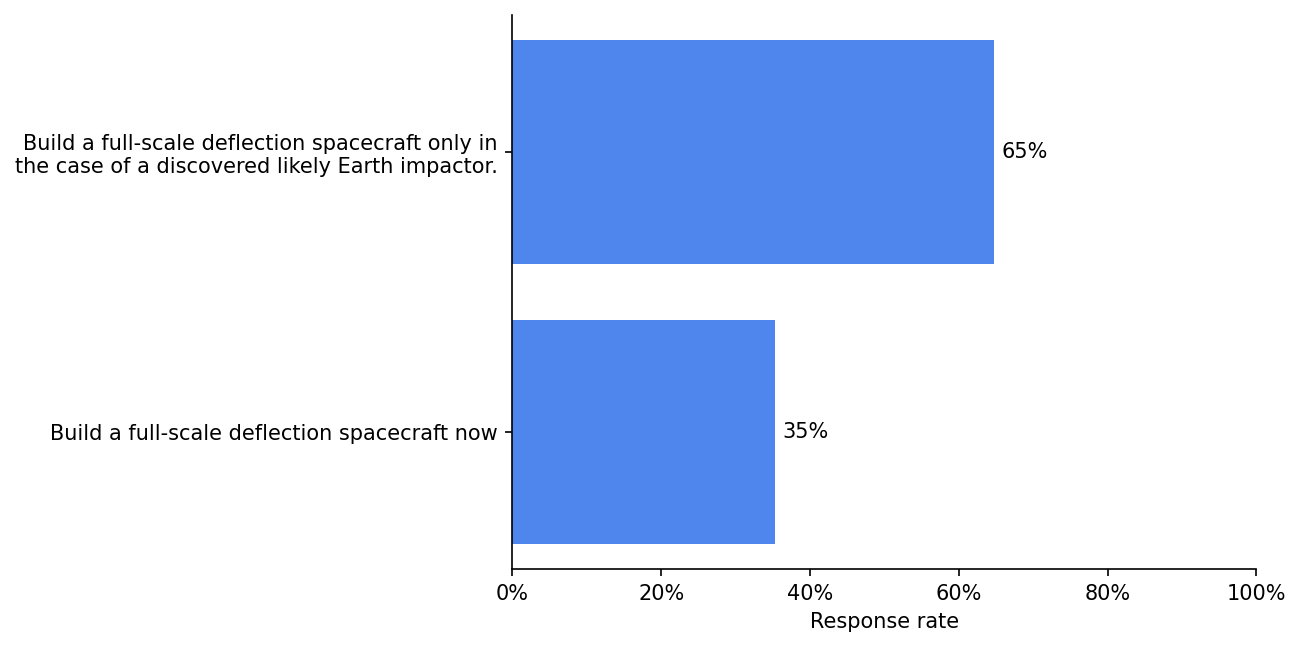

Participant Response Confidence Anonymous
Build a full-scale deflection spacecraft only in the case of a discovered likely Earth impactor. 8 Make sense in what sense? Scientifically and technically, we can build one now and it is good to have one handy. But the bigger question is who is going to pay and lead it. Anonymous
Build a full-scale deflection spacecraft now 3 Anonymous
Build a full-scale deflection spacecraft now 7 If we build it now, it's true that it's possible that we're never going to use it. On the other side, if we have it ready, it's going to be easier to use it if we're going to discover a possible impactor. Anonymous
Build a full-scale deflection spacecraft now 8 Cristina Thomas
Northern Arizona UniversityBuild a full-scale deflection spacecraft only in the case of a discovered likely Earth impactor. 8 Brent William Barbee
NASA/Goddard Space Flight CenterBuild a full-scale deflection spacecraft now 10 Anonymous
Build a full-scale deflection spacecraft only in the case of a discovered likely Earth impactor. 8 My answer to this is mainly a consequence of how designing, building, launching, and staging on-orbit such a deflection spacecraft would incur one time and ongoing costs which would take away from budget available that would be better spent on finding and characterizing NEOs in the first place. Of course, if overall budget available could be increased such that nothing would be taken away from NEO discovery and characterization, then have at it! Anonymous
Build a full-scale deflection spacecraft now 8 Building a spacecraft when the impactor is discovered takes valuable time from the deflection itself. Anonymous
Build a full-scale deflection spacecraft only in the case of a discovered likely Earth impactor. 9 Anonymous
Build a full-scale deflection spacecraft now 6 A full-scale spacecraft should be designed and its efficacy modeled now. It doesn't need to be ready to launch and getting old waiting Alan Harris
Retired, Space Science InstituteBuild a full-scale deflection spacecraft only in the case of a discovered likely Earth impactor. 10 See my paper, Harris, Canavan, Sagan and Ostro (1994), "The Deflection Dilemma", for details of the argument. Anonymous
Build a full-scale deflection spacecraft only in the case of a discovered likely Earth impactor. 7 Physical Characterization of the target would provide critical design requirements for an effective impactor. That's not to say that an array of designs should not be well-developed. Bill Gray
Project PlutoBuild a full-scale deflection spacecraft only in the case of a discovered likely Earth impactor. 2 My answer is based on no special knowledge of the subject. But I think the risk from such an effort being misunderstood/mislabelled ("the US/Illuminati/other group plan to nudge an asteroid to hit XYZ") would actually be greater than the risk from a rock. Anonymous
Build a full-scale deflection spacecraft only in the case of a discovered likely Earth impactor. 9 Anonymous
Build a full-scale deflection spacecraft now 7 Jin Zhu
Beijing PlanetariumBuild a full-scale deflection spacecraft only in the case of a discovered likely Earth impactor. 7 Such a deflection spacecraft might be more dangerous if used improperly. Richard Wainscoat
University of HawaiiBuild a full-scale deflection spacecraft now 6 Eric Christensen
The University of Arizona / Catalina Sky SurveyBuild a full-scale deflection spacecraft only in the case of a discovered likely Earth impactor. 9 Building a deflection spacecraft without knowing target properties, delta-V requirements, or the amount of time needed to maintain a spacecraft at the ready, makes no sense, given what we know about the expected frequency of an impact threats that warrants deflection (thousands to tens of thousands of year timescales). Anonymous
Build a full-scale deflection spacecraft only in the case of a discovered likely Earth impactor. 8 Donald K. Yeomans
NASA/JPL - retiredBuild a full-scale deflection spacecraft only in the case of a discovered likely Earth impactor. 9 The 3 keys to effective mitigation of near-Earth objects are to find them early, find them early and find them early. There should be several years available for building an effective full-scale deflection spacecraft - once a potentially hazardous object is identified well in advance. Anonymous
Build a full-scale deflection spacecraft now 10 Lindley Johnson
NASA HQ PDCOBuild a full-scale deflection spacecraft only in the case of a discovered likely Earth impactor. 8 An asteroid impact of significance is a very rare event, maybe once a century would there be one detected that necessitates deflection. The costs to maintain a viable deflection spacecraft at the ready are better spent for finding any possible threat earlier, and the technology it had been built with will likely be obsolete before it is needed to be used. The strategy should be find the threat early and then use the most up to date technology to deflect. Detlef Koschny
European Space AgencyBuild a full-scale deflection spacecraft only in the case of a discovered likely Earth impactor. 6 This is a tricky one. If we only have a few years, we might not have enough time. On the other hand, if we build it now it doesn't help either. Anonymous
Build a full-scale deflection spacecraft now 5 Fabrizio Bernardi
SpaceDySBuild a full-scale deflection spacecraft now 9 Timothy B. Spahr
NEO Sciences, LLCBuild a full-scale deflection spacecraft only in the case of a discovered likely Earth impactor. 10 Anonymous
Build a full-scale deflection spacecraft only in the case of a discovered likely Earth impactor. 10 Find them early, find them early, find them early. Time is the most valuable asset. Time is more valuable than any intercept hardware. Anonymous
Build a full-scale deflection spacecraft now 8 Michael W. Busch
SETI InstituteBuild a full-scale deflection spacecraft only in the case of a discovered likely Earth impactor. 10 Carl Sagan & Steve Ostro, among many other people these past 30 years, warned about the risks from having deflection spacecraft unnecessarily on standby. Mark Boslough
Los Alamos National Laboratory & University of New MexicoBuild a full-scale deflection spacecraft only in the case of a discovered likely Earth impactor. 10 My position has always been that the vast majority of marginal increases in funding should go to discovery, preferably more space-based surveys. This is like seed money with positive feedback. More discoveries will likely lead to more funding. Anonymous
Build a full-scale deflection spacecraft only in the case of a discovered likely Earth impactor. 5 I feel that anything needing a big deflector will be noticed in time for rapid development. From final approval to launch, DART took just 2 years, with no dire urgency. Anonymous
Build a full-scale deflection spacecraft only in the case of a discovered likely Earth impactor. 7 A deflector built NOW will become obsolete long before a likely impact. William Bottke
Southwest Research InstituteBuild a full-scale deflection spacecraft only in the case of a discovered likely Earth impactor. 10 The probabilities suggest that very few to perhaps zero hazardous bodies are likely to be on an impact trajectory in the near term. Even if we find one, it is not clear deflection is more cost effective than letting it hit, with the probabilities favoring impact in an unpopulated region. This can readily be verified by further study. Therefore, the urgency to develop this technology at this time is not there. Anonymous
Build a full-scale deflection spacecraft only in the case of a discovered likely Earth impactor. 8 -
Question 4
Consider the entire population of asteroids and comets. What do you think the long-term Earth impact frequency is of asteroids and comets >140 meters in diameter, per year? For reference, the impact frequency of near-Earth asteroids only in this range was recently estimated to be 4*10^-5 impacts per year (based on the integrated risks from the values in Figure 8 in Harris, A. W., Chodas, P. W, 2021, Icarus, 365, 114452). Your answer may be your best guess. We are not expecting respondents to perform calculations.Results
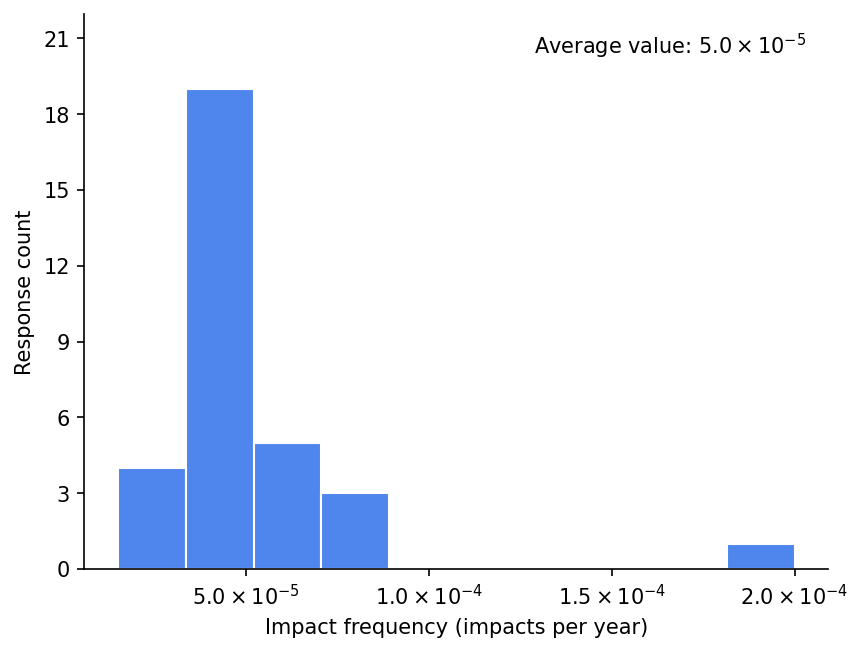
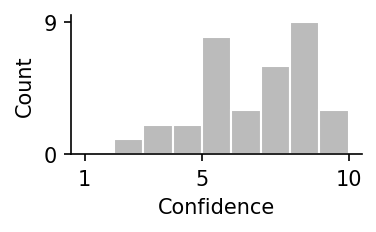
Participant Response Confidence Anonymous
6.0*10^-5 6 Comets represent the largest uncertainty. They also tend to carry larger kinetic energy than asteroids, so smaller comets can do more damage than asteroids of the same sizes. Anonymous
4.0*10^-5 3 Anonymous
3.0*10^-5 2 Anonymous
4.0*10^-5 7 I am not an expert in the field of these calculations so I tend to agree with mentioned Harris, A. W. & Chodas, P. results. Cristina Thomas
Northern Arizona UniversityBrent William Barbee
NASA/Goddard Space Flight Center8.0*10^-5 5 Anonymous
6.0*10^-5 4 Anonymous
4.5*10^-5 4 The published impact-frequency estimate is probably still close, because the majority of asteroids and comets are on stable orbits in the Main Belt and beyond. Anonymous
4.0*10^-5 6 Anonymous
1.5*10^-5 7 about 1 impact in 60,000 to 70,000 years Alan Harris
Retired, Space Science Institute4.0*10^-5 9 The >140 m criterion has lost most of its significance, with the re-evaluation of the (lesser) importance of tsunami. It is now estimated that the maximum risk remaining is from "Tunguska" size impactors. Anonymous
5.0*10^-5 6 Approximate. Bill Gray
Project PlutoI'll bow out to Alan Harris and friends on this one! I can't even think of a way of answering it, short of getting a population model based on what we've already observed and finding out how often the modelled rocks hit us. I don't even have a Fermi estimate for it. Anonymous
6.0*10^-5 10 Extrapolation from bolide energy-frequency distribution below 500 kT. Anonymous
8.0*10^-5 5 Jin Zhu
Beijing Planetarium6.0*10^-5 8 Richard Wainscoat
University of Hawaii6.0*10^-5 7 Eric Christensen
The University of Arizona / Catalina Sky Survey4.0*10^-5 5 I have no reason to doubt the example in the question, within a factor of ~2x. Anonymous
4.0*10^-5 10 Donald K. Yeomans
NASA/JPL - retired4.0*10^-5 8 In the near-Earth neighborhood, comet close Earth approaches are only 1% of the close asteroid approaches. Anonymous
4.0*10^-5 5 Lindley Johnson
NASA HQ PDCO2.0*10^-4 5 I believe there have been many significant impacts that are not captured in the geological record visible today. Detlef Koschny
European Space Agency4.0*10^-5 9 Anonymous
8.0*10^-5 3 Fabrizio Bernardi
SpaceDyS4.0*10^-5 6 Timothy B. Spahr
NEO Sciences, LLC4.0*10^-5 5 Anonymous
4.0*10^-5 10 Hello. The experts deriving this estimate have incorporated all available data. Any number you conclude from a survey of opinions is meaningless. Anonymous
2.0*10^-5 5 Michael W. Busch
SETI Institute4.1*10^-5 10 If anyone has worked out how the different size distributions for comets relative to asteroids and the limited lifetimes of small comets change the impact risk from those objects, I would like to know it. Mark Boslough
Los Alamos National Laboratory & University of New Mexico4.0*10^-5 9 I think Harris et al (2021) is the latest authoritative estimate so I accept it. Long period comets only represent a few percent of the total, so well within their uncertainty. Anonymous
2.0*10^-5 8 I believe Chelyabinsk (20 m) is ~1 per 100 yr, Tunguska (50 m), ~1 per 1000 yr, so I'm putting 140 m around ~1 per 50,000 yr. Anonymous
4.0*10^-5 7 Cometary impacts are extremely unlikely. William Bottke
Southwest Research Institute4.0*10^-5 8 I would argue that we have a good estimate for the NEO size frequency distribution for D > 140 m, and the orbits of NEOs are reasonably well known, which means we have should have a good estimate of their collision probabilities with Earth. With that said, our new work is showing that the orbital distribution of small NEOs is different from those of larger ones. That could modify things at bit, but I suspect our latest solutions will not be radically different from this result. Anonymous
5.0*10^-5 5 -
Question 5
Consider the entire population of asteroids and comets. What do you think the long-term Earth impact frequency is of asteroids and comets >1000 meters in diameter, per year? For reference, the impact frequency of near-Earth asteroids only in this range was recently estimated to be 1.5*10^-6 impacts per year (based on the integrated risks from the values in Figure 8 in Harris, A. W., Chodas, P. W, 2021, Icarus, 365, 114452). Your answer may be your best guess. We are not expecting respondents to perform calculations.Results
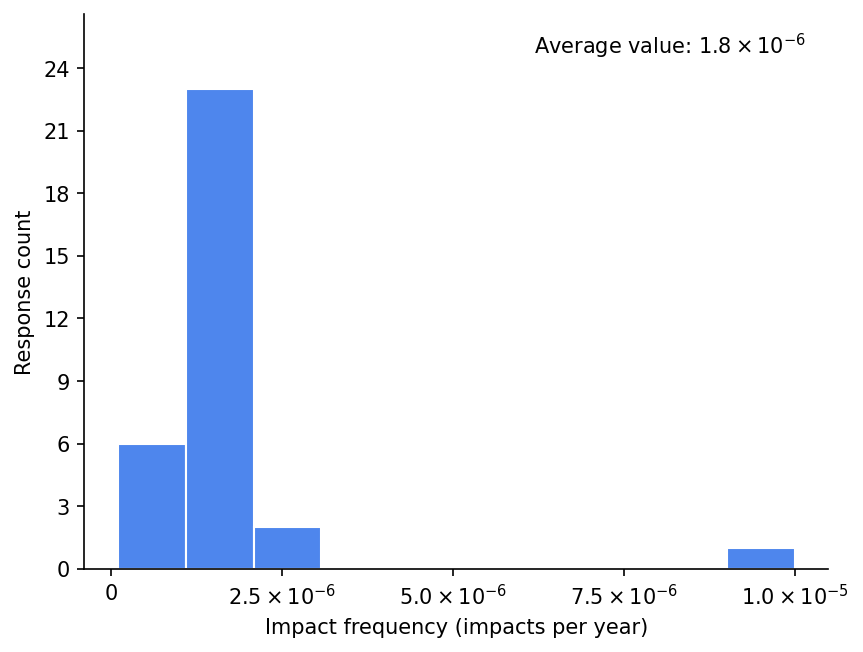

Participant Response Confidence Anonymous
2.0*10^-6 4 Again, comets represent the largest uncertainty. Anonymous
1.0*10^-6 4 Anonymous
1.5*10^-6 5 Anonymous
1.5*10^-6 7 I am not an expert in the field of these calculations so I tend to agree with mentioned Harris, A. W. & Chodas, P. results. Cristina Thomas
Northern Arizona UniversityBrent William Barbee
NASA/Goddard Space Flight Center3.0*10^-6 5 Anonymous
2.0*10^-6 4 Anonymous
1.5*10^-6 8 As previously, the published impact-frequency estimate is probably still close, because the majority of asteroids and comets are on stable orbits in the Main Belt and beyond. Also, in this category the majority of the objects in this size scale has already been discovered and they are also less prone for disturbances. Anonymous
1.5*10^-6 8 Anonymous
1.0*10^-7 7 the likelihood of an unknown large asteroid is extremely low; so if there was an impact, it would likely be caused by a long period comet. I guessed 1 in every 10,000,000 years Alan Harris
Retired, Space Science Institute1.5*10^-6 9 Anonymous
1.6*10^-6 7 Approximate. Bill Gray
Project PlutoSame here. I'd add that while the >140-m objects are obviously worrisome, we shouldn't ignore the Chelyabinsks and Tunguskas; the objects where we don't get much warning, but can tell people to take cover/leave windows open/be someplace else that day. Anonymous
1.0*10^-6 7 Anonymous
3.0*10^-6 5 Jin Zhu
Beijing Planetarium2.0*10^-6 7 Richard Wainscoat
University of Hawaii2.0*10^-6 7 Eric Christensen
The University of Arizona / Catalina Sky Survey1.5*10^-6 5 Anonymous
1.5*10^-6 10 Donald K. Yeomans
NASA/JPL - retired1.5*10^-6 7 The referenced Harris and Chodas paper represents the state of the art for near-Earth object statistics. Anonymous
1.5*10^-6 5 Lindley Johnson
NASA HQ PDCO5.0*10^-7 5 The impact of larger NEOs is probably less frequent than has been thought. Detlef Koschny
European Space Agency1.5*10^-6 9 Anonymous
2.0*10^-6 5 Fabrizio Bernardi
SpaceDyS1.5*10^-6 6 Timothy B. Spahr
NEO Sciences, LLC2.0*10^-6 4 total guess I don't know this stuff Anonymous
1.5*10^-6 10 Hello. The experts deriving this estimate have incorporated all available data. Any number you conclude from a survey of opinions is meaningless. Anonymous
1.0*10^-6 3 Michael W. Busch
SETI Institute1.5*10^-6 10 Mark Boslough
Los Alamos National Laboratory & University of New Mexico1.5*10^-6 9 I think Harris et al (2021) is the latest authoritative estimate so I accept it. Long period comets only represent a few percent of the total, so well within their uncertainty. But since we've discovered ~95% of NEOs, the long period comet fraction may be comparable to the *undiscovered* NEA fraction. Anonymous
1.0*10^-7 8 KT (10 km) was 65 Myr ago so maybe ~1 per Myr for 1 km Anonymous
1.5*10^-6 8 William Bottke
Southwest Research Institute1.5*10^-6 8 We have a good assessment of the km-sized NEOs, and we understand reasonably well their collision probabilities with Earth. The main issue would be whether we are including impact probabilities correctly from the outer solar system, some which take unexpected pathways to get to Earth (Nesvorny et al. 2021). Anonymous
1.0*10^-5 4 -
Question 6
If we learned that a >140 meter asteroid would hit Earth five years from today, what is the likelihood that we could deploy an effective deflection mechanism? [0-100%]Results

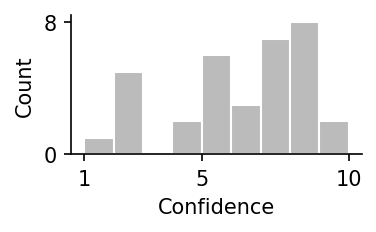
Participant Response Confidence Anonymous
20% 8 We already sort of agree that human activity has led to climate change, but still... Anonymous
80% 4 Anonymous
60% 7 I think I've been too optimistic, but some studies have been performed on how we could deflect an asteroid and the whole system is getting periodically tested with simulations. So I would like to believe that these efforts will be proven useful in the future if we're going to discover an impactor. Anonymous
50% 7 We haven't both suitable mitigation technologies and space carriers up to now. Moreover I am afraid about a possible future international agreement (UN?) with some kind of mitigation (among US-EU-China-Russia-India-Brasilia...) Cristina Thomas
Northern Arizona University70% 6 Once DART is finished, we'll have a better idea of the effectiveness, so this is a loose estimate. I think it will ultimately come down to international cooperation. Brent William Barbee
NASA/Goddard Space Flight Center25% 8 With five years of warning, and considering the various uncertainties and time needed to develop and prepare a mission for launch, it would probably be impractical to *deflect* the asteroid, but *robust disruption* of the asteroid might be possible if the asteroid were not too large relative to how much nuclear device payload we could deliver to it. The biggest challenge would be readying the spacecraft and launch vehicle for deployment on such short notice, so advance preparations for such things is highly advisable. Anonymous
30% 7 All depends on the specific orbit circumstances, of course, but given typical lead times before the date of impact at which a delta-V would need to be applied to the asteroid to accomplish successful deflection, this gives only a year or two to design, build, and launch a spacecraft (probably a kinetic impactor), which seems very unlikely given experience with DART. On the other hand, I don't have a good feel for just how much the aerospace/defense industry would be able to accelerate things vs. "business as usual" given enough budget and serious enough pressure from government and/or society. Anonymous
20% 2 I'm pessimistic about the likelihood of success, because there is no existing spacecraft or a real strategy that would be able to deflect a 140-meter asteroid in only five years, especially with the political turbulence of today added into the equation. For 10 years or more I would be somewhat more optimistic. Anonymous
75% 7 Anonymous
20% 6 low international governmental cooperation and low belief that climate change is a threat therefore why would an asteroid be a threat Alan Harris
Retired, Space Science Institute50% 5 Just nuke it. Current prohibitions would be damned in the case of a certain impact. Anonymous
10% 2 Total Guess Bill Gray
Project PlutoAgain outside what I know. But it seems to me highly dependent on where it would hit, how much delta-V would be required (and in which direction), and on the assumed composition of the target object. As stated, this sounds a bit like "how long is a piece of rope". Anonymous
62% 5 Anonymous
15% 8 Jin Zhu
Beijing Planetarium10% 5 Richard Wainscoat
University of Hawaii40% 4 It's hard to be confident about the political side of this, but we have smart engineers and scientists - I'm confident that the scientists+engineers could do it. But is also depends on the orbit of the object - not such a simple question. Eric Christensen
The University of Arizona / Catalina Sky Survey5% 9 5 years seems too short a timeline to avoid most scenarios involving >140-m asteroids. There might be a few friendly scenarios with smaller asteroids, easier intercept trajectories, and lower delta-V requirements, but that would mostly depend on getting lucky, in addition to carrying off a perfect design/build/launch/intercept campaign. Anonymous
50% 7 Donald K. Yeomans
NASA/JPL - retired75% 8 Anonymous
10% 8 Lindley Johnson
NASA HQ PDCO50% 7 With successful tests like DART I believe the likelihood will increase. Detlef Koschny
European Space Agency60% 6 Here in my view the main uncertainty is 'will we get the money'. From a technical point of view we could do it. Anonymous
85% 8 Fabrizio Bernardi
SpaceDyS37% 5 Timothy B. Spahr
NEO Sciences, LLC75% 7 Super tricky, depends on the orbit etc but I'm fairly confident. Nuclear deflection can be done very late. Anonymous
50% 10 Anonymous
25% 8 5 years is a very short warning time - it takes time to develop a spacecraft and it that is very rapid, then there are windows of opportunities that are narrow and it could be too late to launch anything or achieve sufficient delta_v to deflect the body. Michael W. Busch
SETI Institute50% 1 Insufficient data for a meaningful answer, given how much that depends on the exact trajectory of the asteroid concerned. Mark Boslough
Los Alamos National Laboratory & University of New Mexico5% 8 I do not think we would even attempt such a deployment if the object were to hit in a remote ocean or uninhabited land area, so there's ~10% likelihood we'd even try. Of that, there's probably a 50% chance it would fail either for technical or geopolitical reasons. So 5% Anonymous
50% 5 It depends how ">" that is! 10 km? No chance. At the low end, a few hundred m, we have the technology today, in principle (DART). Anonymous
20% 3 In five years a fast flyby to characterize the object would be feasible. William Bottke
Southwest Research Institute5% 5 It is very difficult to construct and launch a new mission in 5 years without any preliminary planning or preparation. That also assumes we also know how to deflect an asteroid whose properties may not be well understood. Anonymous
73% 3 -
Question 7
If we learned that a >140 meter comet would hit Earth five years from today, what is the likelihood that we could deploy an effective deflection mechanism? [0-100%]Results
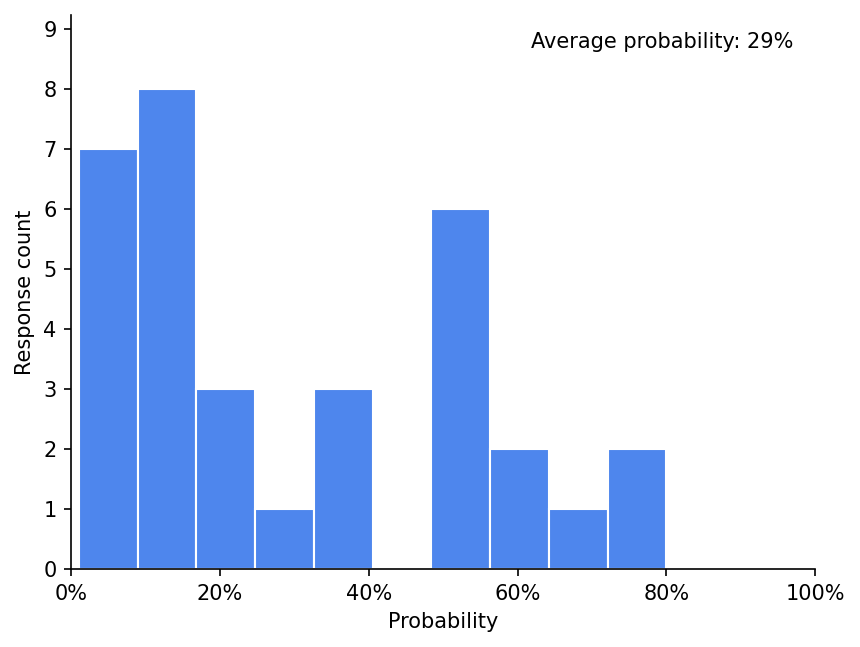
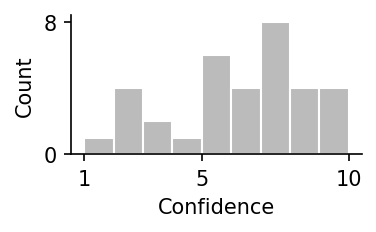
Participant Response Confidence Anonymous
10% 8 Given that most short-period comets have been discovered (yes?) this is largely a long-period comet, and we know too little about them. Anonymous
80% 4 Anonymous
40% 7 Comets might be tricky and I don't think we have paid enough attention on those bodies. Anonymous
50% 7 We haven't both suitable mitigation technologies and space carriers up to now. Moreover I am afraid about a possible future international agreement (UN?) with some kind of mitigation (among US-EU-China-Russia-India-Brasilia...) Cristina Thomas
Northern Arizona University35% 2 Comets are a whole different thing-- both from a physical/structural stand point and from their orbital dynamics. We can use the lessons we've learned, but it's hard to say if they'll apply. Brent William Barbee
NASA/Goddard Space Flight Center20% 8 See my previous comments about the incoming asteroid scenario. Comets are even more difficult to deal with on short notice because the notice is generally shorter than for asteroids and comet orbits tend to be more difficult to interact with via spacecraft. Anonymous
8% 7 Comet deflection would be significantly harder than asteroid deflection for the same size, given 1) the greater magnitude and different direction of the V_infinity vector for a typical cometary Earth-approach, and 2) the challenges of hitting such a small body at such higher speeds, and 3) especially considering out-gassing and coma effects' detriments to any deflection spacecraft's optical navigation and terminal guidance. Anonymous
15% 3 I'm even more pessimistic about the likelihood of success for comets because in addition to the fact that there is no existing spacecraft or a real strategy that would be able to deflect a 140-meter asteroid in only five years, comet orbits are less predictable than asteroid orbits, which makes mission planning even more challenging. Anonymous
60% 7 Anonymous
15% 6 I don't think as much modeling has been done with comets than asteroids Alan Harris
Retired, Space Science Institute50% 5 Pretty unlikely that such a comet would be discovered 5 years out, and even less likely that an impact could be predicted with any confidence more than a year out, due to non-grav effects on orbit. So the 5-year lead time suggested is fantasy. Anonymous
5% 2 Total Guess Bill Gray
Project PlutoI know even less about comets than I do about asteroids... Anonymous
20% 9 Anonymous
10% 7 Jin Zhu
Beijing Planetarium5% 5 Richard Wainscoat
University of Hawaii10% 3 Comets will be harder to deflect, and we might not have good enough astrometry 5 years out to know that it would hit Earth. Eric Christensen
The University of Arizona / Catalina Sky Survey2% 9 Too short a timeline. Long-period comet intercept has never been demonstrated, and would presumably be much more challenging than other intercept/flyby missions. Anonymous
50% 7 Donald K. Yeomans
NASA/JPL - retired50% 5 Cometary impacts are extremely unlikely. The vast majority of near-Earth objects are asteroidal in nature. Anonymous
10% 8 Lindley Johnson
NASA HQ PDCO50% 6 I don't see a significant difference in our capability to mitigate between small asteroids and comets if they are discovered in enough time to react. However, small comets coming in from the outer solar system are hard to detect 5 years in advance. Detlef Koschny
European Space Agency60% 6 Anonymous
70% 7 Fabrizio Bernardi
SpaceDyS11% 7 Comets are usually faster than asteroids. Therefore, they need much more DeltaV Timothy B. Spahr
NEO Sciences, LLC75% 6 Anonymous
20% 10 Anonymous
1% 10 not enough time, the comet is very fast, delta_v too high Michael W. Busch
SETI Institute50% 1 See earlier response. Mark Boslough
Los Alamos National Laboratory & University of New Mexico3% 8 Same as above, but we'd have less warning if it were a long period comet so I reduced the likelihood of success by a factor of 2. Anonymous
25% 5 Tougher problem given the likely much higher encounter speed. Plus comets that get near us tend to be bigger than the asteroids that get near us. (Fortunately there are far fewer near-Earth comets!) Anonymous
10% 5 An incoming comet would have a higher v-infinity speed than an asteroid and would therefore be harder to deflect. William Bottke
Southwest Research Institute5% 5 Same as above. Comets are more fragile, which could be good or bad. The main issue is launching a mission within 5 years from scratch. That sounds hard. Anonymous
38% 2 -
Question 8
If we learned that a >1000 meter asteroid would hit Earth five years from today, what is the likelihood that we could deploy an effective deflection mechanism? [0-100%]Results
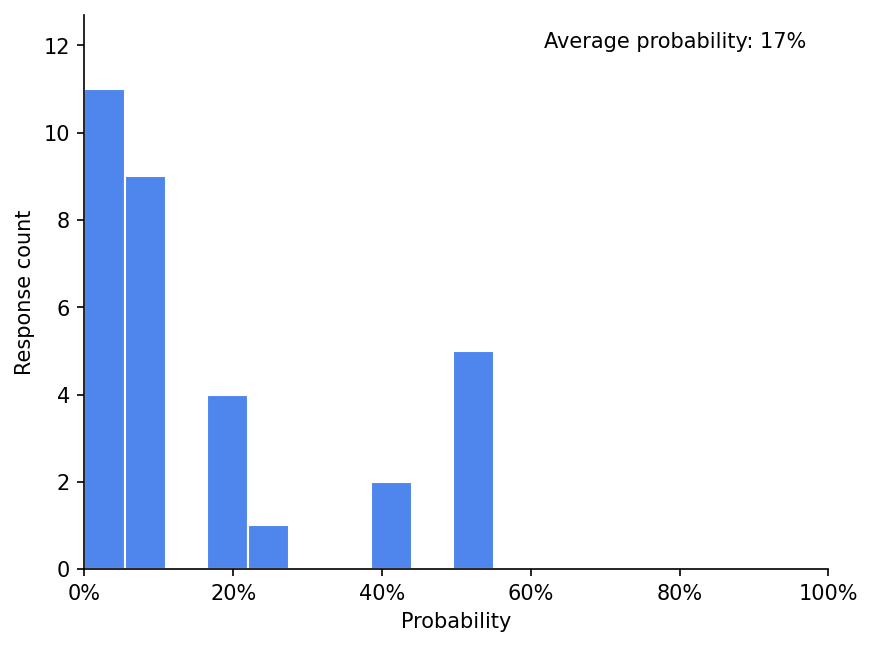
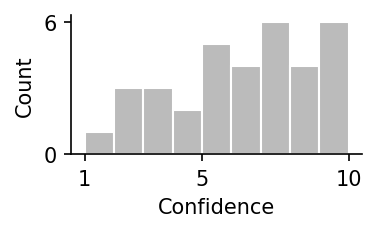
Participant Response Confidence Anonymous
10% 9 Anonymous
25% 5 Anonymous
40% 7 All our efforts have been focused on deflecting small asteroids. I'm not sure about how much this could be translated in the deflection of a larger object. Anonymous
20% 7 We haven't both suitable mitigation technologies and space carriers up to now. Moreover I am afraid about a possible future international agreement (UN?) with some kind of mitigation (among US-EU-China-Russia-India-Brasilia...) Cristina Thomas
Northern Arizona University5% 3 That is a much larger target, we'd probably need a lot more time for any changes in orbit to help. Brent William Barbee
NASA/Goddard Space Flight Center10% 8 Deflecting or disrupting such a large asteroid with only five years of warning would be extremely difficult, even with nuclear devices. With proper preparations, we could increase the probability of being able to handle such a scenario. However, we should also endeavor to find such objects with more than five years of warning in the first place. NASA's NEO Surveyor telescope would greatly improve the likelihood of discovering Earth-impacting objects with more warning time. Anonymous
55% 6 Bigger target, easier to hit, although you'd need orders of magnitude more momentum or energy to apply the same delta-V. However, given the severity of such an Earth-impact, I would expect it to be far more likely to have enough budget and serious enough pressure from government and/or society to make this happen. Anonymous
10% 7 I'm very pessimistic about the likelihood of success, because there is no existing spacecraft or a real strategy that would be able to deflect a 1000-meter asteroid in only five years. Anonymous
20% 7 Anonymous
10% 6 Alan Harris
Retired, Space Science Institute50% 3 Unlikely enough that I wouldn't worry (or waste tax monies) over it. Anonymous
10% 2 Bill Gray
Project PlutoAnonymous
10% 4 Anonymous
0% 8 Jin Zhu
Beijing Planetarium2% 5 Richard Wainscoat
University of Hawaii5% 3 Eric Christensen
The University of Arizona / Catalina Sky Survey0% 9 Too much mass to move on such a short timescale. Anonymous
50% 7 Donald K. Yeomans
NASA/JPL - retired50% 6 Anonymous
40% 8 Lindley Johnson
NASA HQ PDCO20% 5 The larger the object, the harder it will be to be successful. Detlef Koschny
European Space Agency10% 6 Anonymous
10% 4 Fabrizio Bernardi
SpaceDyS3% 9 Timothy B. Spahr
NEO Sciences, LLC2% 7 I hope this never happens. Moving a big object that late is near impossible. Anonymous
2% 10 Anonymous
10 there isn't a method developed for such a large object but the probability is very low for such a large object (almost all are discovered). Michael W. Busch
SETI Institute50% 1 See earlier response. Mark Boslough
Los Alamos National Laboratory & University of New Mexico1% 8 We would have to depend on being lucky that its impact point was near the Earth's edge in the b-plane and that it was in an easy orbit. The probability of a successful deflection under this circumstance is close to zero but the probability of the circumstance happening is also close to zero. Anonymous
10% 5 At that scale we would likely need multiple launches and nukes would need to be on the table. Anonymous
0% 10 Not even close. William Bottke
Southwest Research Institute5% 5 One would likely have to use nuclear weapons, and it is unclear we understand how to use them properly to deflect a km-sized body or whether we have weapons on hand that could do the job. Anonymous
20% 2 -
Question 9
If we learned that a >1000 meter comet would hit Earth five years from today, what is the likelihood that we could deploy an effective deflection mechanism? [0-100%]Results
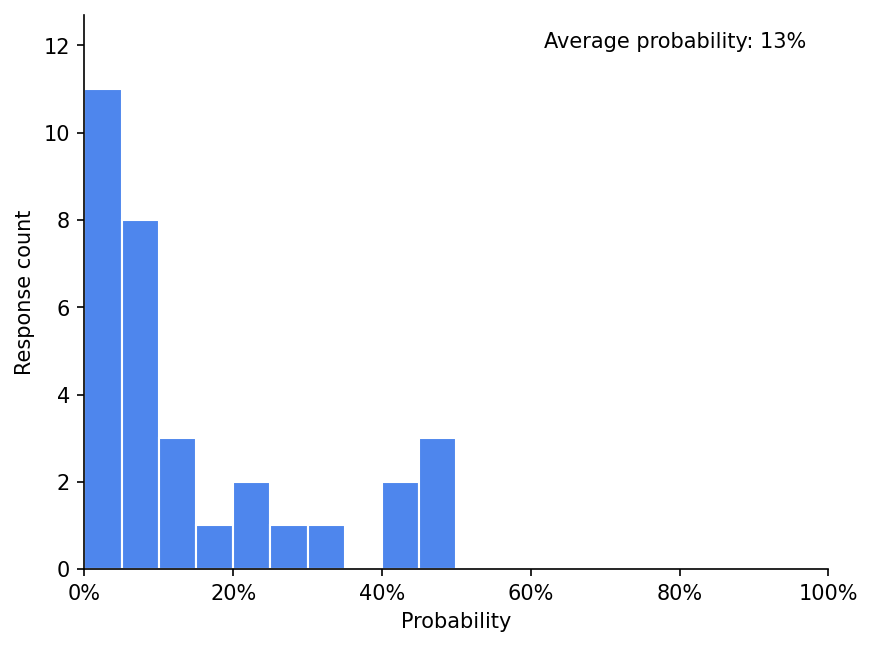
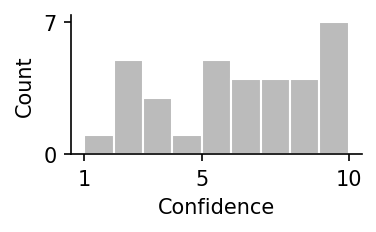
Participant Response Confidence Anonymous
5% 9 Anonymous
25% 5 Anonymous
20% 7 It's a combination of the previous two answers. Anonymous
10% 7 We haven't both suitable mitigation technologies and space carriers up to now. Moreover I am afraid about a possible future international agreement (UN?) with some kind of mitigation (among US-EU-China-Russia-India-Brasilia...) Cristina Thomas
Northern Arizona University1% 3 Much larger target, unknown physical characteristics, different orbit type. There is a lot that makes this seem incredibly unlikely to me. Brent William Barbee
NASA/Goddard Space Flight Center6% 8 See my previous comments about the incoming asteroid scenario. Comets are even more difficult to deal with on short notice because the notice is generally shorter than for asteroids and comet orbits tend to be more difficult to interact with via spacecraft. Anonymous
30% 5 Again, all other things being equal, comet deflection would be significantly harder than asteroid deflection. Anonymous
5% 9 I'm very pessimistic about the likelihood of success, because there is no existing spacecraft or a real strategy that would be able to deflect a 1000-meter comet in only five years. The number of challenges is vast. Anonymous
15% 7 Anonymous
10% 6 Alan Harris
Retired, Space Science Institute50% 3 As with smaller comet, a five year prediction would have no merit due to non-grav orbit variation Anonymous
3% 2 Bill Gray
Project PlutoAnonymous
5% 10 Anonymous
0% Probably a long-period comet, would need to have been discovered some years previously to be certain of an earth impact in 5 years. To be visible 7-8 years out, it would have to be >> 1 km (think C/1995 O1 (Hale-Bopp), seen at r = 13 AU four years before perihelion). Jin Zhu
Beijing Planetarium1% 5 Richard Wainscoat
University of Hawaii3% 3 Comets will be harder to deflect, and we might not have good enough astrometry 5 years out to know that it would hit Earth. Eric Christensen
The University of Arizona / Catalina Sky Survey0% 10 Anonymous
50% 7 Donald K. Yeomans
NASA/JPL - retired40% 6 Large (>1 km) Earth-approaching asteroids and comets would almost certainly be discovered and tracked well in advance of the 5 year period. Anonymous
40% 8 Lindley Johnson
NASA HQ PDCO20% 4 Same comment applies as to small comets. Detlef Koschny
European Space Agency10% 6 Anonymous
5% 3 Fabrizio Bernardi
SpaceDyS1% 10 Timothy B. Spahr
NEO Sciences, LLC5% 6 We might be able to blow up the comet. Maybe. Anonymous
1% 10 Anonymous
8 There isn't a method developed for such a large and fast object. Deflection methods are usually not dealing with comets. Michael W. Busch
SETI Institute50% 1 See earlier response. Mark Boslough
Los Alamos National Laboratory & University of New Mexico1% 8 We are down in the noise and the answer is effectively zero. But the probability of this scenario happening is also effectively zero. Anonymous
5% 5 Even worse for comets, for the reasons previously stated. Anonymous
0% 10 Not a chance. William Bottke
Southwest Research Institute5% 5 Same as above Anonymous
4% 2 -
Question 10
There has been a rapid increase in the number of artificial satellites launched, with US Federal Communications Commission filings indicating that tens of thousands could be launched in coming years. How concerned are you about these satellites directly or indirectly (via Kessler syndrome) interfering with near-Earth object discovery?Results
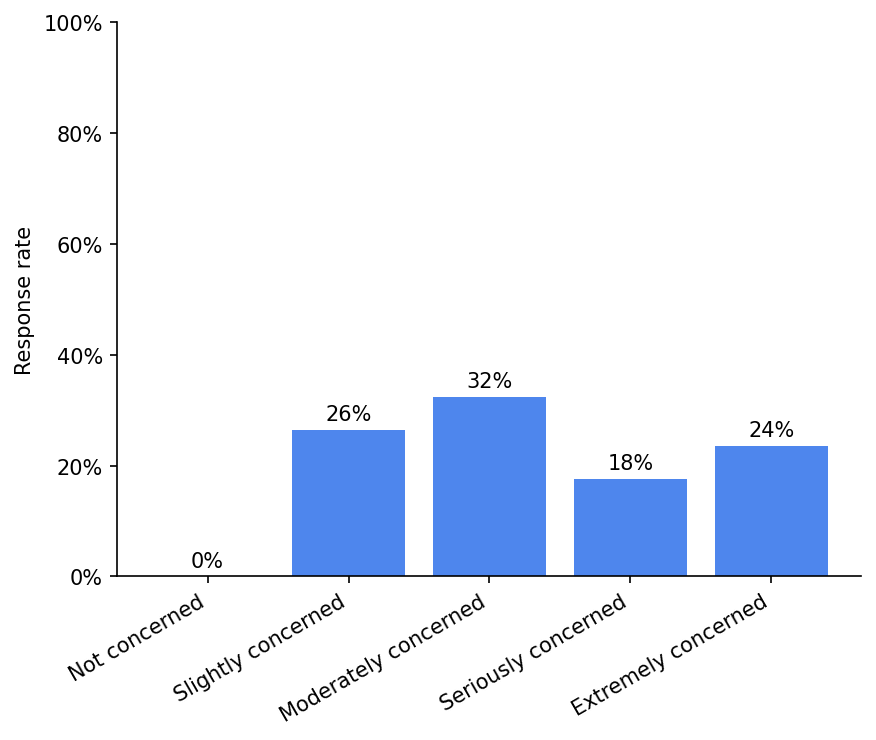
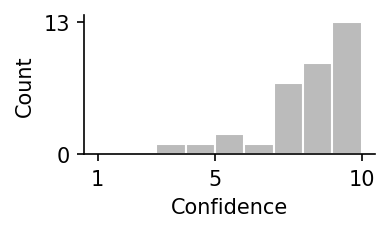
Participant Response Confidence Anonymous
Extremely concerned 10 Studies (e.g. Mroz et al. 2022) have shown that LEO satellites can severely affect observations taken during twilight and that is an important parameter space for NEO search. Anonymous
Moderately concerned 3 Anonymous
Seriously concerned 9 Anonymous
Extremely concerned 10 Moreover to destroing observing skies especially for fainter NEO targets for ground based telescopes (search, follow-up astrometry, physical studies...), such flood of artificial satellites will posse a risk for launching of mitigation mission (trying to save humankind) in future. Cristina Thomas
Northern Arizona UniversityExtremely concerned 10 I think it's absolutely terrible that nothing concrete is being done to combat this issue. This is only going to get worse and make a lot of problems for ground-based discovery. Brent William Barbee
NASA/Goddard Space Flight CenterModerately concerned 8 Anonymous
Extremely concerned 9 Sufficient space-based telescopes placed safely w.r.t. the Earth-orbital debris situation may be our only hope here ... Anonymous
Seriously concerned 7 Anonymous
Moderately concerned 8 Anonymous
Moderately concerned 8 Alan Harris
Retired, Space Science InstituteSlightly concerned 5 Anonymous
Moderately concerned 8 Bill Gray
Project PlutoSlightly concerned 7 Thus far, it seems we can mostly work around these objects, more so than some of our colleagues in other areas of astronomy. But they aren't all up there yet, and the ones in higher orbits (which can be seen at larger elongations) worry me a little bit. Anonymous
Extremely concerned 10 Anonymous
Extremely concerned 8 Jin Zhu
Beijing PlanetariumModerately concerned 7 Richard Wainscoat
University of HawaiiExtremely concerned 10 The satellites basically render swaths of the detector unusable for detection of NEOs, and the tracks compound/sum for the 4 images used to find NEOs. Eric Christensen
The University of Arizona / Catalina Sky SurveySlightly concerned 7 A well-designed, NEO-focused survey can be made robust against losing occasional images (or fractions of images) due to satellite trails. I've estimated that a fully built-out Starlink megaconstellation may degrade Catalina Sky Survey's detection efficiency by a few tenths of a percent. General-purpose astrophysical surveys that also attempt to detect NEOs by linking sparse detections across many nights may be more susceptible to additional "noise" from satellite trails. Anonymous
Slightly concerned 9 Donald K. Yeomans
NASA/JPL - retiredModerately concerned 7 Anonymous
Seriously concerned 8 Lindley Johnson
NASA HQ PDCOSlightly concerned 7 A space-based capability like NEO Surveyor will not be affected by this. However, other space endeavors beyond NEO discovery could be more and even greatly affected. Detlef Koschny
European Space AgencySlightly concerned 8 Anonymous
Slightly concerned 9 Fabrizio Bernardi
SpaceDySSlightly concerned 8 Timothy B. Spahr
NEO Sciences, LLCModerately concerned 6 Anonymous
Slightly concerned 10 Space-based assets are the correct advancement of NEO discovery. Groundbased search assets are of diminishing importance. Anonymous
Moderately concerned 7 I am more concerned about the Kessler syndrome, inability to launch any spacecraft safely in a decade or two from now...either space telescope or deflection mission could be affected/damaged. Michael W. Busch
SETI InstituteExtremely concerned 10 It is way past time to stop letting corporations unilaterally make a mess of the sky. Mark Boslough
Los Alamos National Laboratory & University of New MexicoModerately concerned 4 That's out of my area of expertise but I think I'm reflecting what I've heard from survey experts. Anonymous
Seriously concerned 8 This is a big problem, mitigated only by having space assets monitoring possible threats (NEO Surveyor, etc.). Anonymous
Seriously concerned 10 Artsats move much faster on the sky than asteroids, so they can be filtered out by motion detections software. William Bottke
Southwest Research InstituteModerately concerned 5 I have not studied the problem. My insights would come from those in the trenches doing surveys, and I have not talked to them. Anonymous
Seriously concerned 10 -
Question 11
What is one thing you wish more people knew about comets and asteroids?Results
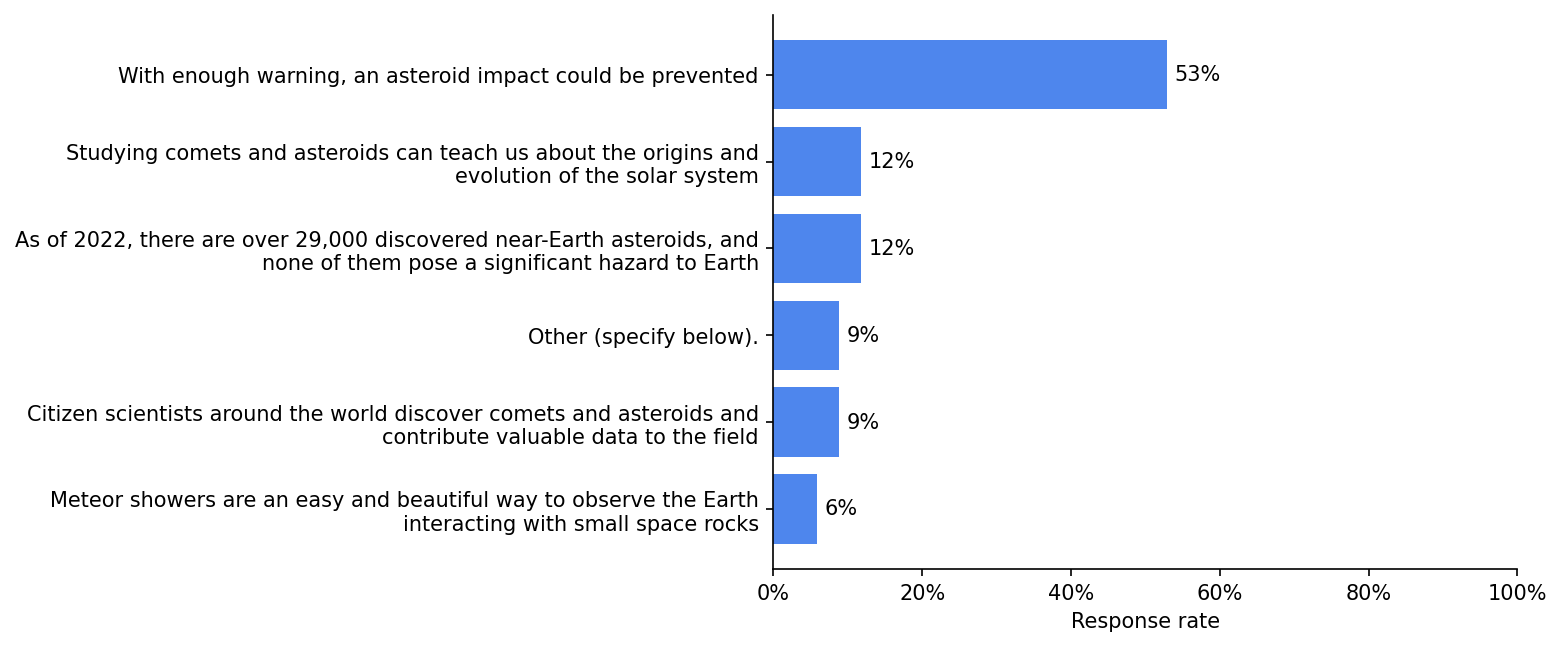
Participant Response Confidence Anonymous
Citizen scientists around the world discover comets and asteroids and contribute valuable data to the field Anonymous
With enough warning, an asteroid impact could be prevented Anonymous
With enough warning, an asteroid impact could be prevented People are scared about asteroids and during the pandemic I heard multiple times that the pandemic was like discovering an asteroid that was going to impact the Earth and that's nothing we can do about it. I think that the public should better understand all the efforts in place to prevent the impact of an asteroid with our planet. Anonymous
With enough warning, an asteroid impact could be prevented It is necessarry to say that only worldwide cooperation can save us (humankind) from hazardous asteroids. Of course, I understand it could be VERY difficult, but, as Brian G. Marsden said many years ago: "Cooperation, not competition." Cristina Thomas
Northern Arizona UniversityAs of 2022, there are over 29,000 discovered near-Earth asteroids, and none of them pose a significant hazard to Earth Brent William Barbee
NASA/Goddard Space Flight CenterWith enough warning, an asteroid impact could be prevented Asteroids and comets simultaneously hold the keys to securing our future and the clues to understanding our ancient past. Anonymous
With enough warning, an asteroid impact could be prevented The importance of solving / mitigating the climate crisis is paramount, and solving / mitigating the Earth-orbital debris situation probably comes after that in priority but is still extremely serious. Planetary defense is a lower priority than these, but given that we can prevent an impact with enough warning, planetary defense is a far more worthwhile investment than most of our economic activity. And again, within the domain of planetary defense the priority should be finding them first (discovery and orbit characterization) even though those are the parts of the field we have MOST figured out, at present. This is what can provide enough warning time. Anonymous
Meteor showers are an easy and beautiful way to observe the Earth interacting with small space rocks Anonymous
With enough warning, an asteroid impact could be prevented Anonymous
With enough warning, an asteroid impact could be prevented Alan Harris
Retired, Space Science InstituteStudying comets and asteroids can teach us about the origins and evolution of the solar system Always carry science long for the ride, since it is highly unlikely a truly threatening asteroid or comet will ever be found. SETI provides a good example: after decades waiting for ET to call home, and no peripheral benefits while looking, the government got tired of funding further searches. Continuing ones are privately funded. If you want to continue dipping into the public funds, you need peripheral results (science return) along the way. Anonymous
Studying comets and asteroids can teach us about the origins and evolution of the solar system Bill Gray
Project PlutoOther (specify below). All good things to publicize. I've talked about all of them, with the focus varying on the audience. I sometimes explain that we've got most of the planet-killers (1 km or so) accounted for and are not so worried about them at present, but still have a lot of country/city killers to find. Then there are the smaller rocks that would produce correspondingly smaller, but still significant, disasters... and we've barely got a start on them. Anonymous
With enough warning, an asteroid impact could be prevented Anonymous
With enough warning, an asteroid impact could be prevented Jin Zhu
Beijing PlanetariumOther (specify below). All the future Earth impactors are on their way to us. Deflection will make us safer or in more dangerous. Richard Wainscoat
University of HawaiiMeteor showers are an easy and beautiful way to observe the Earth interacting with small space rocks Eric Christensen
The University of Arizona / Catalina Sky SurveyWith enough warning, an asteroid impact could be prevented I also wish that there were fewer copy-pasted news stories with titles like "Monster truck-sized asteroid skims dangerously close to Earth; scientists blindsided!". Anonymous
With enough warning, an asteroid impact could be prevented Donald K. Yeomans
NASA/JPL - retiredAs of 2022, there are over 29,000 discovered near-Earth asteroids, and none of them pose a significant hazard to Earth Anonymous
Studying comets and asteroids can teach us about the origins and evolution of the solar system Lindley Johnson
NASA HQ PDCOWith enough warning, an asteroid impact could be prevented These are all important things for people to know, but if I must pick one the understanding that early detection of a potential impact threat is key to a successful mitigation would be it. Detlef Koschny
European Space AgencyWith enough warning, an asteroid impact could be prevented Anonymous
Citizen scientists around the world discover comets and asteroids and contribute valuable data to the field Fabrizio Bernardi
SpaceDySCitizen scientists around the world discover comets and asteroids and contribute valuable data to the field Timothy B. Spahr
NEO Sciences, LLCWith enough warning, an asteroid impact could be prevented Anonymous
As of 2022, there are over 29,000 discovered near-Earth asteroids, and none of them pose a significant hazard to Earth Anonymous
With enough warning, an asteroid impact could be prevented Michael W. Busch
SETI InstituteWith enough warning, an asteroid impact could be prevented Mark Boslough
Los Alamos National Laboratory & University of New MexicoOther (specify below). The impact risk (in terms of expected losses over the next century) is dominated by small objects <140 m that have not been discovered. Statistics and probability tell us that asteroids & comets like the K/Pg impactor are not what we should be worried about. Anonymous
As of 2022, there are over 29,000 discovered near-Earth asteroids, and none of them pose a significant hazard to Earth Thanks for the interesting survey! Anonymous
With enough warning, an asteroid impact could be prevented William Bottke
Southwest Research InstituteStudying comets and asteroids can teach us about the origins and evolution of the solar system Some of the issues involved with planning a mission to meet a near term threatening body are discussed in the Decadal Survey (OWL Report). They have a lot to say on this. Anonymous
With enough warning, an asteroid impact could be prevented
